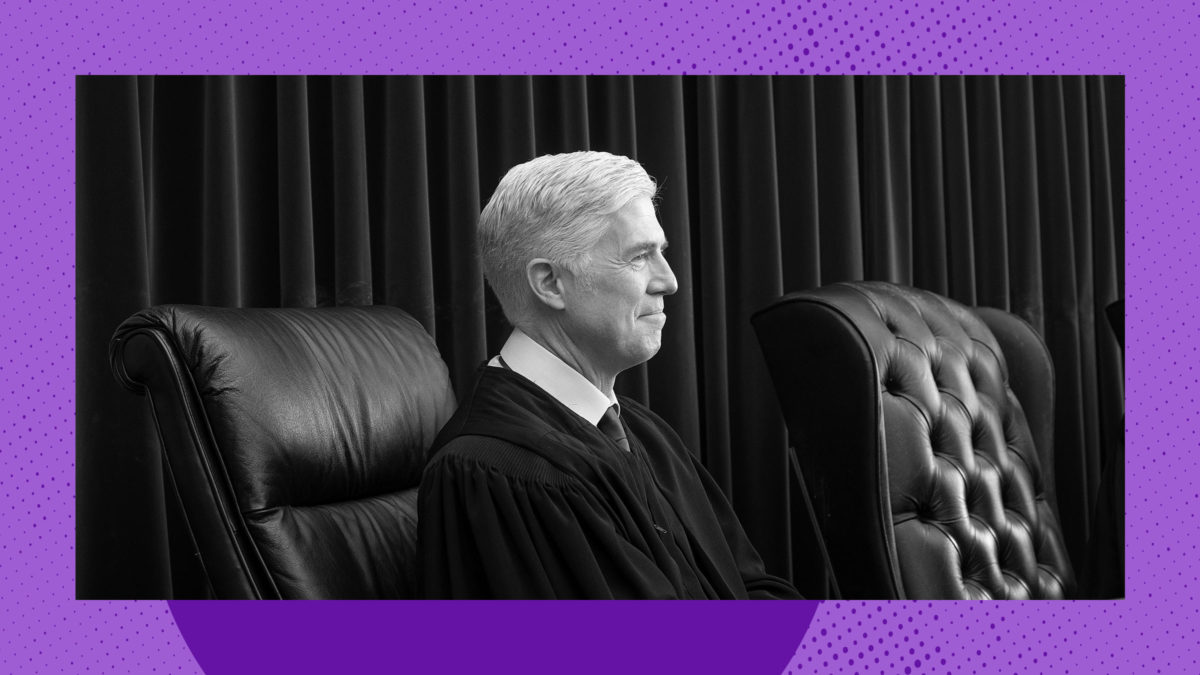Eleven weeks before the 2016 presidential election, a judge on the Tenth Circuit Court of Appeals launched his campaign for a seat on the Supreme Court. There were no stirring speeches or cheering crowds. Instead, Judge Neil Gorsuch issued a lengthy concurring opinion in a case called Gutierrez-Brizuela v. Lynch in which he laid out the program he would pursue if given the top job.
Judges typically write concurring opinions when they agree with the result but disagree with their colleagues’ reasoning, or think the majority devoted too little attention to an important point. But Gorsuch authored the majority opinion in Gutierrez-Brizuela. He wrote separately to concur with himself in a 23-page opinion that did not mention the petitioner or outline a course of action the Tenth Circuit might adopt in the future. Instead, he devoted the entire concurrence to making an argument that the Supreme Court should overturn one of the modern conservative legal movement’s most-despised cases: Chevron v. Natural Resource Defense Council.
The Tenth Circuit has no power to overrule the Supreme Court, of course. Gorsuch was opining about something that was, quite literally, none of his business, as long as he remained a mere circuit court judge. By proposing a course of action only a Supreme Court justice could follow, he was effectively saying, “Give me the job and this is what I’ll do.” David Feber, a former Gorsuch clerk, wrote in the Yale Journal on Regulation that Gorsuch’s Gutierrez-Brizuela concurrence “electrified administrative law scholars.” Libertarian law professor Jonathan Adler touted it in The Washington Post as a “compact and powerful argument.”
What was so “electrifying” about it? To explain, we need to set our Way Back Machine to the early 1980s, when young Neil was still a student at Georgetown Prep. A closely-watched case was winding its way through the federal judicial system: Environmentalists had challenged an industry-friendly Environmental Protection Agency regulation concerning smokestack emissions. In the lower courts, the case was known as Natural Resources Defense Council v. Gorsuch, the Gorsuch in question being Neil’s mother Anne, President Ronald Reagan’s EPA chief. When the case hit the Supreme Court, however, the first named petitioner became Chevron, and the case has been known by the oil giant’s name ever since.

Neil Gorsuch is sworn in as a federal appeals court judge in 2006 (Denver Post Photo By John Prieto / Getty Images)
In a landmark decision issued on February 29, 1984, the Supreme Court upheld the regulation. The opinion for the Court, written by Justice John Paul Stevens, concluded that agency choices about statutory implementation are fundamentally political, not legal, and therefore properly made by “the incumbent administration” rather than by judges. Because the EPA’s regulation was a reasonable interpretation of the governing statute, the Court would not disturb it. The opinion was unanimous, but only six justices signed on; Justices Thurgood Marshall and William Rehnquist were absent for health reasons, and Justice Sandra Day O’Connor recused herself due to her inheritance of a financial interest in one of the parties to the case.
Stevens’s Chevron opinion built on a line of precedent stretching back decades. As far back as 1944, in Skidmore v. Swift & Co., the court recognized judges should treat with respect the “rulings, interpretations and opinions” of an executive branch agency, since the agency’s determinations will be “based upon more specialized experience and broader investigations and information than is likely to come to a judge in a particular case.” Formalized into a two-step process, the idea that judges should allow policy decisions on technical subjects to be made by the people whose job it is to make them became known as “Chevron deference”—which Gorsuch placed squarely in his sights in his Gutierrez-Brizuela concurrence more than three decades later.
Gorsuch’s argument was built on a series of contradictions to which he seemed oblivious. He wrote about the risk that an executive agency might at any time change its interpretation of a statute; the solution, he asserted, was to overturn Chevron. An altered agency interpretation would indeed disrupt settled expectations within the affected sector of the economy. But overturning long-established Supreme Court precedent would do so across all sectors. Choosing large-scale immediate disruption to avoid possible future disruption, as Gorsuch advocated, is like burning down your neighborhood to avoid a future house fire. Moreover, if deference were abolished, as Gorsuch advocated, policy swerves would become more common, not less, as judges substitute their preferences for those of agency heads.
Gorsuch also scoffed at the very notion of administrative agency officials determining congressional intent, much less implementing it. “Trying to infer the intentions of an institution composed of 535 members is a notoriously doubtful business under the best of circumstances,” he wrote. By contrast, he confidently informed the reader what “the framers” would have thought about numerous issues of modern-day concern, from stare decisis to the powers of administrative bodies that didn’t exist at the time of the founding. Unlike Congress, the framers shared a single Borg-like intention, readily identifiable by Gorsuch himself from the emanations of the penumbras of cherry-picked quotations. Like any good Trumpist, he accused Chevron of doing what he was doing himself, stridently lauding the principle of separation of powers even as he sought to concentrate power in the judicial branch.
Americans have been living with the administrative state for many generations. For all that time, right-wing politicians have run against it. By its nature, regulation imposes compliance costs on regulated companies, while its benefits—cleaner air, safer air travel, electrical grids that don’t seize up in a freeze—are shared across society. This is impossible to reconcile with Milton Friedman’s dictum, accepted as an article of faith by many on the right, that the only social duty of a corporation is to maximize profits. But because the benefits of regulation are understandably popular, conservatives have been unable to gain the voter support necessary for the system’s “deconstruction,” to use Steve Bannon’s word.
Gorsuch proposed an easier way to achieve Bannon’s goal: cut the voters out. He argued that judges should defer to the policy decisions of administrative agencies only when those agencies confine their activities to (a) the making of factual findings and (b) the filling-in of “‘details’ (like, say, the design of an appropriate tax stamp).” Otherwise, he contended, judges should feel free to impose their own policy choices by second-guessing agencies. Whether he would have felt the same way if Democrats controlled the Supreme Court is perhaps an open question.
Today, Gorsuch is still fighting the same fight to get rid of Chevron, except now as one of nine Supreme Court justices with the power to do so. In 2019’s Gundy v. U.S., he wrote a dissent, joined by Chief Justice John Roberts and Justice Clarence Thomas, in which he argued that courts should defer to agency decision-making only when the agencies confine themselves to “filling up details and finding facts.” It was a Gutierrez-Brizuela redux, and although he came up short in that case, two new justices have taken the bench since. Both are what our former President called, with pride of ownership, “Trump judges.”
Gutierrez-Brizuela didn’t earn headlines outside of legal academia at the time it was decided. But the opinion was a glimpse into America’s future. Gorsuch told us what he wants. It seems certain he has the votes he needs. Now, he’s only waiting for the right case to come before the Court.

